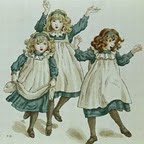 Philosopher Cordelia Fine, who wrote a book on the neuroscience and other studies of the differences between men’s and women’s brains – and found most of them flawed – pauses to target a classic in evolutionary psychology: Why girls prefer pink.
Philosopher Cordelia Fine, who wrote a book on the neuroscience and other studies of the differences between men’s and women’s brains – and found most of them flawed – pauses to target a classic in evolutionary psychology: Why girls prefer pink.
… psychologists and journalists now speculate on the genetic and evolutionary origins of gendered color preferences that are little more than fifty years old.
Little more than how many years old? Read on:
For example, a few years ago an article in an Australian newspaper discussed the origins of the pink princess phenomenon. After trotting out the ubiquitous anecdote about the mother who tried and failed to steer her young daughter away from the pink universe, the journalist writes that the mother’s failure “suggests her daughter was perhaps genetically wired that way” and asks, “is there a pink princess gene that suddenly blossoms when little girls turn two?”Just in case we mistake for a joke the idea that evolution might have weeded out toddlers uninterested in tiaras and pink tulle , te journalist then turns to prominent child psychologist Dr. Michael Carr-Gregg for further insight into the biological basis of princess mania: “The reason why girls like pink is that their brains are structured completely differently to boys,” he sagely informs us. “Part of the brain that processes emotion and part of the brain that processes language is one and the same in girls but is completely different in boys … “
– Delusions of Gender: How Our Minds, Society, and Neurosexism Create Difference, p. 208.
Okay, but if Dr. Carr-Gregg and other authorities are correct, the pace of evolution has been nothing short of catastrophic in recent decades. Formerly, blue was the colour for girls – and for boys?:
The preferred color to dress young boys in was pink! Blue was reserved for girls as it was considered the paler, more dainty of the two colors, and pink was thought to be the stronger (akin to red). It was not until WWII that the colors were reversed and pink was used for girls and blue for boys… –Dress Maker Magazine
Certainly, in Kate Greenaway’s late 19th century illustrations, fashionable girls strut in blue.
Fine also informs us that the early 20th century saw a concerted move to use infant and toddler clothes to reinforce gender differences. But that requires consumer choice. Most children’s clothing of long ago was pretty functional – swaddling clothes, smocks, et cetera, and cut down adult clothes. Few people could afford dyes of their choice.
So yes, it’s evolution – a very recent evolution of ideas about gender, which might depart with no offspring.
See also: Neuroscience: Philosopher rips “drivel” – pop science media ‘s bread and butter
Neuroscience and popular culture: Who do voodoo? They do! Social neuroscientists, that is:
Neuroscience shows why women love shopping, why gay guys read maps like women, why jealous guys … come to think of it, why does social neuroscience only tell us what we already heard from that high school drop-out cousin, shooting pool down in the rec room between his split shifts at the loading dock?
Is this really science? Probably not, say a team of statisticians, who took a look at some of these studies. Basically, many of the claimed correlations were simply too high to be possible. That was because the “social neuroscience” people were cherry picking the data.”
Gender Genie: Fritz your wits about which sex you belong to?
Using an algorithm developed by Moshe Koppel, Bar-Ilan University in Israel, and Shlomo Argamon, Illinois Institute of Technology, you can find out whether the genie thinks you are a man or a woman by submitting a sample of your writing.
Given that the genie works best on texts of more than 500 words, I have decided to submit my five most recent columns for ChristianWeek.
Neuroscience: Vive la difference between boys and girls?
What I find really interesting is the way people are always looking for confirmation of weird theories from neuroscience, but they won’t accept actual evidence that disconfirms a weird theory. For exmaple, there is way more evidence that boys and girls are different than that weird materialist theories of religion are true.
Incidentally, none of these findings shows that girls can’t excel in math and science. They help us understand why many girls do not TRY to excel in math and science. That’s useful information, however we choose to use it.